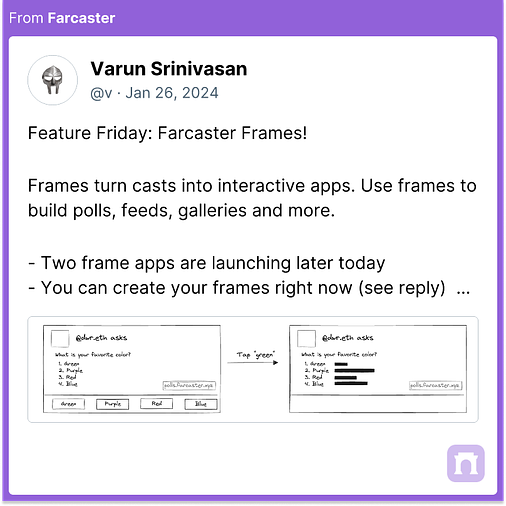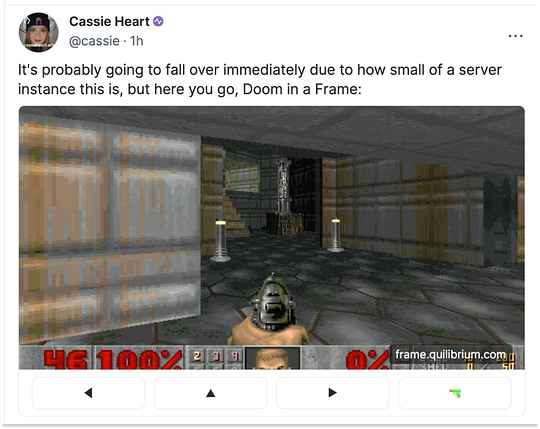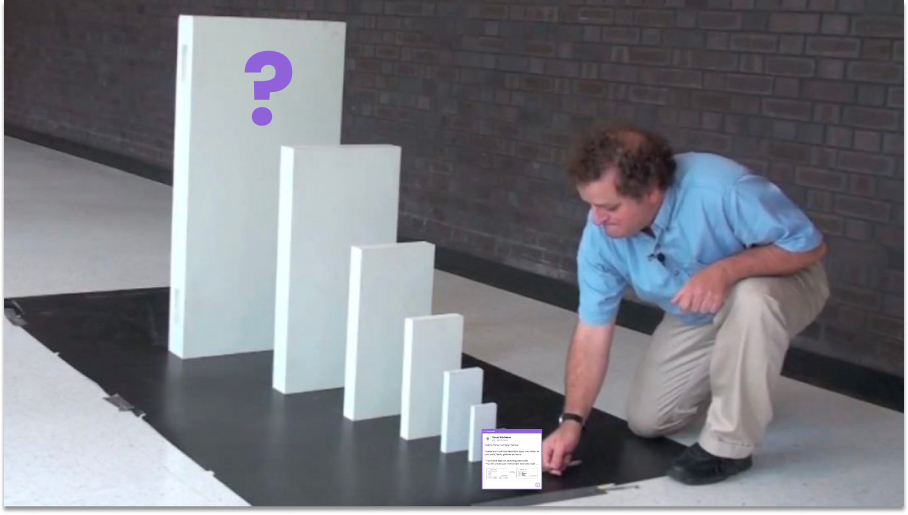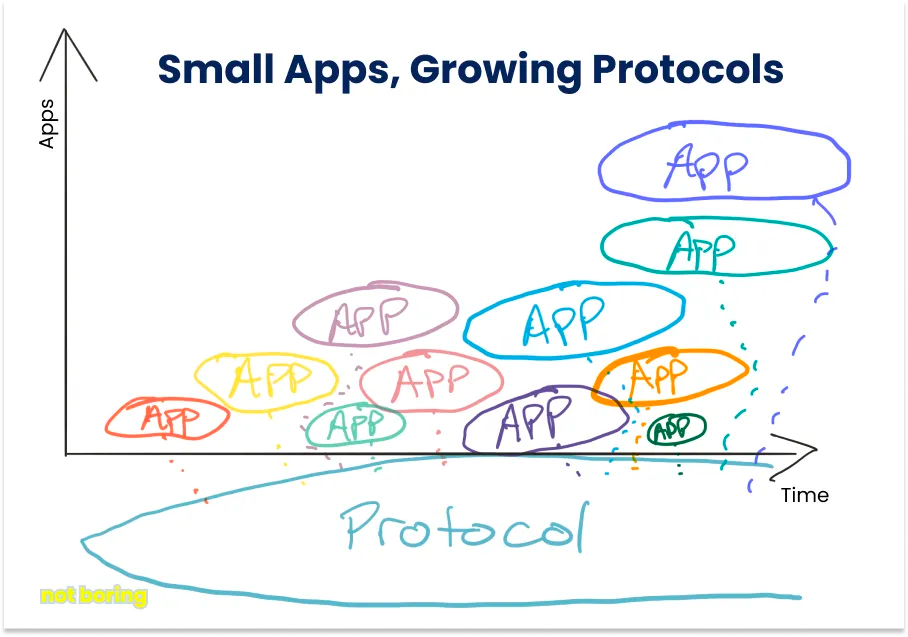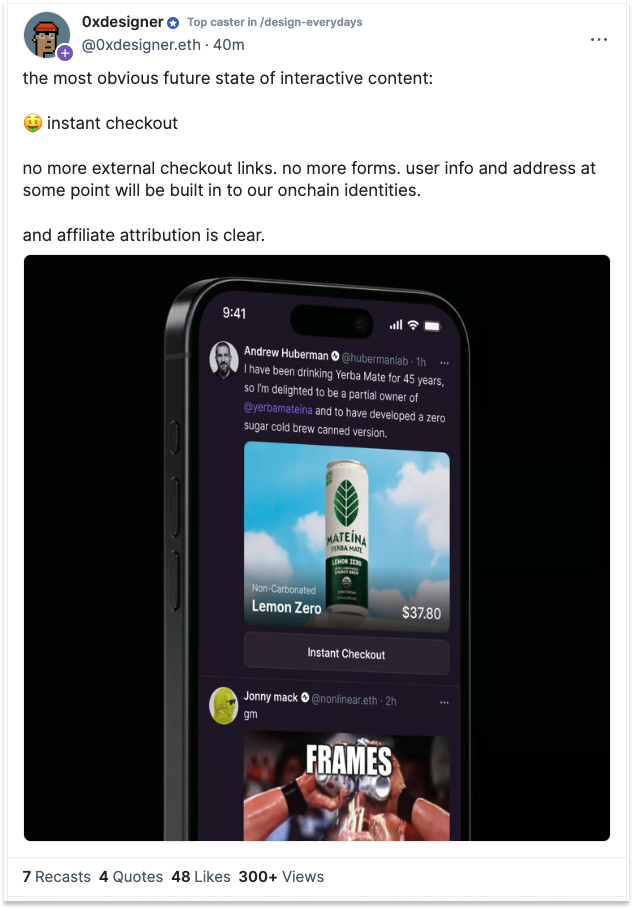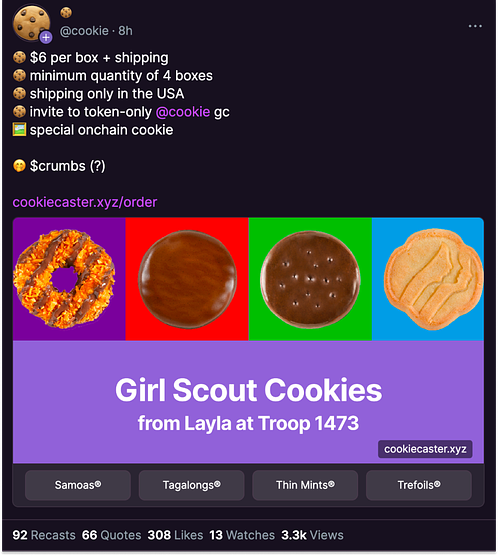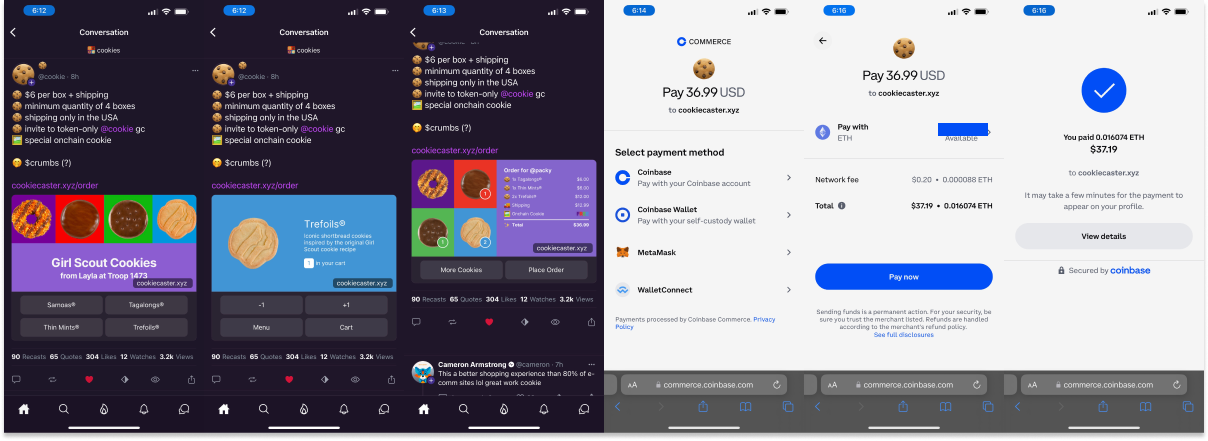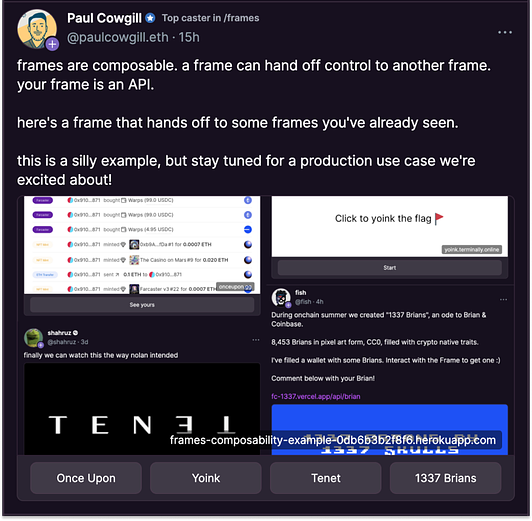Not Boring by Packy McCormick - Framing the Future of the Internet
Welcome to the 364 newly Not Boring people who have joined us since last week! If you haven’t subscribed, join 219,232 smart, curious folks by subscribing here: Hi friends 👋, Happy Tuesday! Today’s piece is about a company I’ve mentioned a few times over the past couple years, Farcaster. Farcaster is a crypto company, a decentralized social network, but I want you to try to not think about it with any of the baggage you might associate with crypto as you read this piece. Think about it as a platform or a network. In Chris Dixon’s new book, Read Write Own, which comes out today, he uses the term “blockchain network” as an alternative to corporate networks like Facebook and Twitter and protocols networks like SMTP and HTTP. “Blockchains are the only credible, known architecture,” he writes, “for building networks with the societal benefits of protocol networks and the competitive advantages of corporate networks.” Farcaster is a blockchain network. The benefits of blockchain networks can be hard to grok in the abstract. What’s happening at Farcaster is a concrete and approachable example of why they might win, playing out in real time. To see it for yourself, join Farcaster. Cast me a hello when you’re there @packy and share a link to this essay, and I’ll recast it to welcome you. Let’s get to it. Framing the Future of the InternetFarcaster’s Very Small Apps Are a Very Big Deal The god of the internet has a sense of humor, or at least a sense of timing. In the same week that Apple proved that regulators can’t stop its App Store monopoly with its frustrating response to the EU’s Digital Markets Act (DMA), Farcaster released Frames. The connection between Apple’s App Store monopoly and Farcaster’s Frames might not be immediately obvious – it might turn out not to exist at all – but Frames is the most compelling example of why blockchain networks might ultimately disrupt corporate networks I’ve come across. It puts a bunch of ideas I’ve been writing about into production. Let me take a step back, though. Starting with a couple questions you might be asking: what is Farcaster and what are Frames? Farcaster is a sufficiently decentralized social network founded by Dan Romero and Varun Srinivasan. Farcaster is a protocol, responsible for storing things like user’s handles, casts (Farcaster’s version of tweets), and reactions (like likes and recasts). Anyone can build their own clients on top of Farcaster that use that data but offer different frontend experiences. Clients are interfaces through which users access the feed. We don’t use that word “client” much anymore, because in most modern social networks, like Twitter and Facebook, the protocol and the client are the same thing. Twitter used to have clients, like Tweetdeck and Twitterific, until it shut down its API access and killed the clients. Now, Twitter is just Twitter (or, if you prefer, X). You can think of Farcaster as a Twitter that’s extensible by its community and always will be. The Farcaster team built its own client, Warpcast, but any developer is free and encouraged to create their own competing client. Many have. a16z crypto has a list of General and Specialized clients in their awesome-farcaster repo, including Supercast, Yup, Searchcaster, Launchcaster, Eventcaster, and Casthose. Each takes a different twist to the frontend experience of accessing Farcaster’s data and interacting with its users. A few months ago, the Farcaster team introduced channels as a way to organize conversations by topic. The Farcaster team created the first few channels, and then opened up the ability to create new channels to any user. Once created, those channels show up in any client that chooses to build them in, with all of the same casts you’d see in Warpcast. And on Friday, Farcaster launched Frames. Frames let people build small apps that run inside of casts. They’re essentially small, interactive iframes embedded in casts, hence the name. Like casts, handles, and channels, Frames work in any Farcaster client. Frames can support anything from Doom to polls to block explorers to mints to buys to prediction markets. Frames are just a canvas; developers will figure out what to paint on them. And they are! In the four days since launch, developers have built Frames that let users mint songs in one click, subscribe to a newsletter in one click, and play games right in their feed, including Doom. (Fun fact: there’s a long history of people running Doom in weird places, from pregnancy tests to vapes and chainsaws.) You can feel Warpcast buzzing with ideas. You can see the buzz in the Farcaster DAU chart. The absolute number of daily active users is still small (although Dan Romero casted that it’s now over 14k), but there’s clearly something special happening. On Friday, I shared Chris Dixon’s new book, Read Write Own, in the Weekly Dose and mentioned two of my favorite essays of his: The next big thing will start out looking like a toy and What the smartest people do on the weekend is what everyone else will do during the week in ten years. Early Frames activity is a mashup of the two. A lot of the early Frames look like toys, and a lot of smart people spent this past weekend building them. The crypto VC fund Variant hosted a Frames hackathon Sunday with 50 people in-person and hundreds online. Coinbase’s Jesse Pollak set up a group chat for people building Frames that have onchain components, and hit the 100 person cap in five hours. People and companies are offering bounties for the best Frame ideas using Bountycaster, a product that Linda Xie is building on top of Farcaster – people, to get things they want built, and companies, to pay people to use their products (APIs, layer 2’s, etc…) as they build them. I can try to describe the energy around Frames all day, but the best way to understand what I’m talking about is to join Warpcast to watch it unfold in real-time. A lot of people have written about Frames already. It’s the biggest story in crypto right now, because as Antonio Garcia Martinez wrote:
I’m going to write about it, too, because Frames feels like the beginning of something big. Whether it’s the first domino to fall towards toppling Twitter, killing Apple’s App Store monopoly, or creating something entirely unique, it’s too early to tell. But it’s a domino. Seeing it play out over the past few days, I’ve felt like Leo in Once Upon a Time in Hollywood: Frames are a real, tangible example of three things I’ve been writing about:
I’ll cover each in turn. Small Applications, Growing ProtocolsIn Small Applications, Growing Protocols, I wrote about the fact that apps are getting easier to build and harder to sustain. Companies like Lensa, Poparazzi, BeReal, Dispo, and Clubhouse gained millions of users, and even made millions of dollars, before fading away. Variant’s Li Jin made a similar point in a recent essay, “In a sense, consumer products now resemble entertainment, with users regularly wanting to try out the latest thing and then quickly moving on.” So what to do? I proposed a third path beyond raising money or bootstrapping:
Turns out, I wasn’t thinking small enough. Frames are very small apps, some meant to be as fleeting as a tweet, others to serve as portals to larger apps, like Sound or Paragraph. Developers and creators gain distribution, and the Farcaster protocol gains activity and users. Crypto’s UX has been famously terrible (although it’s improving). With Frames, users can go to one feed instead of a hundred different apps to do the various things they might want to do. That’s good for the developers and creators, because it means one place to reach thousands (and maybe someday millions) of users and frictionless conversion. Li’s partner at Variant Jesse Walden calls Frames a new go-to-market strategy, writing:
And it’s good for Farcaster, because it means that thousands of developers and creators will be working to build experiences that attract activities and users, and that the Farcaster protocol has a shot at becoming the center of gravity for onchain activity. Thousands of small apps (Frames) working to grow one protocol (Farcaster). From Experimentation to InfrastructureThe relationship between apps and protocols is a specific example of a more general relationship I’ve been thinking about a lot recently: experimentation and infrastructure. Good infrastructure enables experimentation; experimentation solidifies infrastructure. In Pace Layers, I wrote that “Strong infrastructure and good governance provide freedom through constraint.” Stable infrastructure provides a base for experimentation: the stronger and more stable the infrastructure, the easier it is to experiment on top of it. By making it incredibly easy to experiment, and by guaranteeing that users’ “identity and data can’t be rugged from underneath you,” Farcaster encourages more experimentation. The relationship works the other way, too. The more experimentation there is at the top layer, the more stable the infrastructure below it becomes. One way to visualize the role of platforms in the context of Pace Layers is by thinking of experiments – or apps – as weights. The more experiments run on top of a platform, the deeper into the layers the platform sinks and the more firmly it’s held in place. Farcaster itself started as an experiment. The Farcaster team made the only Farcaster client, Farcaster, which looked like a less functional Twitter clone for a small group of Ethereum people. With nothing built on top of it, it was light enough to float away. Over time, it’s opened up. Farcaster the client became Warpcast, and other developers built their own clients on top of the Farcaster protocol. Warpcast introduced Channels to help people find casts related to their interest, and then let anyone create their own Channels. With the introduction of Frames, Farcaster is making it easier to build apps within Casts. Each thing that people build on top of the Farcaster protocol – clients, apps, channels, and Frames – adds weight to the protocol that pushes it into the infrastructure layer and cements it there. And the more deeply established the Farcaster protocol is as infrastructure, the more people will build on top of it. More experimentation is a good thing for its own sake. Novelty is the feedstock of progress. And experimentation is good for the platforms that enable it. Ben Thompson explained it in a way that has stuck with me in Shopify and the Power of Platforms:
The easier it is to experiment on a platform, the more failures and successes there will be, and the greater the likelihood the platform itself will win. I’m going to include a long block quote here, which Dan will hate, because I think Ben says it so well (emphasis mine):
You can find and replace “Amazon” with “Twitter,” “Walmart” with “Threads,” and “Shopify” with “Farcaster” and the argument works just as well. (I’m not trying to make the ecommerce analogy directly, but interestingly, Alex Danco, who works on making Shopify wallet aware, tweeted: “frames are a key missing piece of ecommerce infra that now suddenly works.” This thing has levels.) By enabling widespread opportunity and encouraging competition (for attention) and churn at the experimentation layer, and building an aligned ecosystem of developers who benefit from a larger and more engaged community of users, Farcaster has the opportunity to build differentiated social infrastructure and succeed where other Twitter competitors have failed. Why Blockchain Networks WinBuilding new infrastructure bottoms-up is a slow, messy, winding process. It looks like the experimentation layer until it becomes part of the infrastructure layer. There are all of these attributes of blockchain networks that people in crypto like to talk about, things like decentralization, composability, and permissionlessness. I like to write about those things, too, but I get that they can seem a little abstract. A bet that blockchain networks will win is a bet that these attributes will, over time, allow richer ecosystems to develop on top of them. One of the reasons you might want those attributes is to prevent bad things from happening. When Twitter killed Substack links back in April of last year, I wrote a piece called Crypto (Could) Fixes This about how sufficiently decentralized social networks like Farcaster could prevent things like that from happening.
Defense wins championships, but defense is also boring. It’s hard to attract a lot of users to a new product with a “just-in-case” value proposition. Another reason you might want those things is to enable more good things to happen. That’s how great products that millions of people use get built: by creating differentiated experiences that people love. Frames is a tangible example of that kind of decentralization, composability, and permissionlessness in action.
More succinctly, Frames allow anyone, anywhere to easily build small apps with capabilities that grow as other people build new things, with the knowledge that the platform can’t change the rules on them. We’re just starting to see what’s possible, even if early experiments look like toys. I expect that in the coming weeks and months, people will build easy ways to send payments, sell tickets, and do all sorts of things that happen a few clicks away from the feed on Twitter. One possible use case that I’m particularly excited by are prediction markets Frames, one of the ideas I’ve seen mentioned most since the launch. Instead of simply firing off random predictions, the prediction markets Frame might let people express their conviction by putting their money where their mouth is. Casting pessimistic predictions is easy; it would be great for humanity if it were a little more expensive. With prediction frames, I suspect that there would be a lot of signal in what currently amounts to a lot of noise. Live sports betting makes a lot of sense, too. Farcaster already has channels for the major sports leagues and teams. Adding betting in those channels would make Farcaster the social place to gather around live sports. (Obviously, rules vary by jurisdiction.) 0xdesigner highlighted another killer use case: Instant Checkout. That one is compelling because it removes friction from commerce (onchains capitalism) in a way that one-click checkout companies could only dream of (they don’t have their own social feeds) and enables attribution in a way that marketers dream of. If I share a product in a Frame and you buy it, it’s clear that I’m the one who got you to buy it. The brand can send affiliate revenue right into my wallet, no tracking link required. And it will only be possible thanks to composability: as developers build zero-knowledge tools that allow me to store my personal information and address in a wallet without exposing them to the world, anyone building an Instant Checkout Frame can plug them in permissionlessly. Update: I wrote this section last night, and this morning, I woke up to this: Of course, I ordered Girl Scout Cookies directly from my feed (2 Trefoils, 1 Tagalongs, 1 Thin Mints). The experience isn’t one-click yet, but it was really smooth. I made my order, added it to my cart, and checked out. The @cookie account sent me a cast with a link to my cart. I entered my address, checked out with Coinbase Commerce, and paid in ETH. Smooth. I couldn’t have asked for a better example of the composability, permissionlessness, and experimentation I’m talking about. Yesterday afternoon, someone proposed Instant Checkout. Last night, someone built it. Over the next few days, the swarm of builders will remix it and improve on the process. And speaking of remixing, Frames themselves are composable, as Once Upon’s Paul Cowgill pointed out. Builders can make Frames of Frames, snapping them together to create entirely new experiences. This feels like what the internet is supposed to feel like. A lot of people are talking and writing about Frames. The hype is deserved. This is a really big deal. But – don’t say it, don’t say it – we’re still so early. Developers and creators will dream up things that I can’t, and build an increasingly rich ecosystem in the process. Maybe one day, as the gravity of its infrastructure and user base pull in more and more developers, Farcaster will topple Twitter. Maybe it will obviate the need for App Stores altogether by throwing the things people do in apps right in the feed, one click away. More likely, it will create something new and different and potentially more powerful: a social protocol on top of which anyone can build products that take payments, purchases, mints, predictions, and all of the other primitives that developers develop for granted. This isn’t about “onboarding the next billion users to crypto.” It’s about using blockchain networks to do things that billions of people want to do, better. That’s how blockchain networks win, and how builders and users win in the process. I think this might be the one. Frames are small apps with big implications. Thanks to Dan for editing! That’s all for today. We’ll be back in your inbox with a Weekly Dose on Friday. Thanks for reading, Packy |
Older messages
Weekly Dose of Optimism #78
Friday, January 26, 2024
Read Write Own, Gene Therapy, CAR T Cells, Bridge RNA, sama Chips, Prophetic
The Techno-Industrial Revolution
Tuesday, January 23, 2024
Leveraging Technology for Higher Margins in Big Industries
Weekly Dose of Optimism #77
Friday, January 19, 2024
Melei, Ultrasound, Micro-supercolliders, Optimus Folds, Alpha Geometry
The Experimentation Layer
Tuesday, January 16, 2024
You need to f*** around to find out.
Weekly Dose of Optimism #76
Friday, January 12, 2024
Figure, Rabbit, Emissions Decline, Blood-Brain Barrier, RetroPFG
You Might Also Like
🔮 $320B investments by Meta, Amazon, & Google!
Friday, February 14, 2025
🧠 AI is exploding already!
✍🏼 Why founders are using Playbookz
Friday, February 14, 2025
Busy founders are using Playbookz build ultra profitable personal brands
Is AI going to help or hurt your SEO?
Friday, February 14, 2025
Everyone is talking about how AI is changing SEO, but what you should be asking is how you can change your SEO game with AI. Join me and my team on Tuesday, February 18, for a live webinar where we
Our marketing playbook revealed
Friday, February 14, 2025
Today's Guide to the Marketing Jungle from Social Media Examiner... Presented by social-media-marketing-world-logo It's National Cribbage Day, Reader... Don't get skunked! In today's
Connect one-on-one with programmatic marketing leaders
Friday, February 14, 2025
Enhanced networking at Digiday events
Outsmart Your SaaS Competitors with These SEO Strategies 🚀
Friday, February 14, 2025
SEO Tip #76
Temu and Shein's Dominance Is Over [Roundup]
Friday, February 14, 2025
Hey Reader, Is the removal of the de minimis threshold a win for e-commerce sellers? With Chinese marketplaces like Shein and Temu taking advantage of this threshold, does the removal mean consumers
"Agencies are dying."
Friday, February 14, 2025
What this means for your agency and how to navigate the shift ͏ ͏ ͏ ͏ ͏ ͏ ͏ ͏ ͏ ͏ ͏ ͏ ͏ ͏ ͏ ͏ ͏ ͏ ͏ ͏ ͏ ͏ ͏ ͏ ͏ ͏ ͏ ͏ ͏ ͏ ͏ ͏ ͏ ͏ ͏ ͏ ͏ ͏ ͏ ͏ ͏ ͏ ͏ ͏ ͏ ͏
Is GEO replacing SEO?
Friday, February 14, 2025
Generative Engine Optimization (GEO) is here, and Search Engine Optimization (SEO) is under threat. But what is GEO? What does it involve? And what is in store for businesses that rely on SEO to drive
🌁#87: Why DeepResearch Should Be Your New Hire
Friday, February 14, 2025
– this new agent from OpenAI is mind blowing and – I can't believe I say that – worth $200/month

